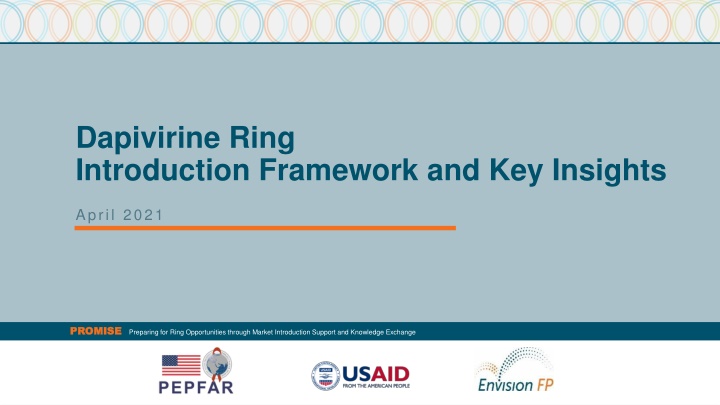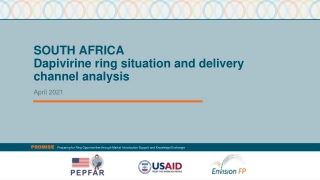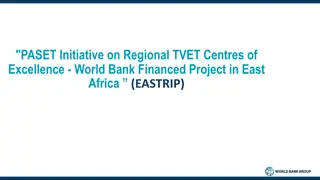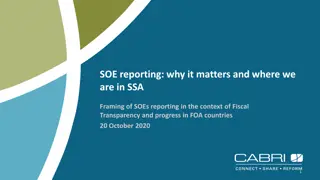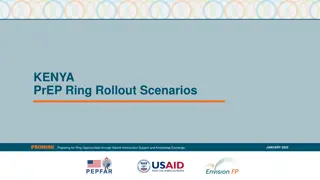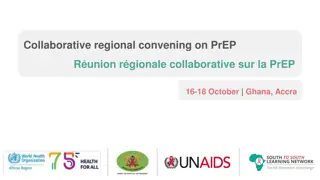Analysis of Dapivirine Ring Introduction Framework and Key Insights in Sub-Saharan Africa
Highlighting strengths, challenges, and key questions on introducing the dapivirine ring in sub-Saharan Africa based on secondary research, stakeholder interviews, and insights from HIV prevention projects. Anticipated benefits include expanded choice for women and AGYW, leveraging existing oral PrEP plans, and integrating the ring with current monitoring systems.
Download Presentation

Please find below an Image/Link to download the presentation.
The content on the website is provided AS IS for your information and personal use only. It may not be sold, licensed, or shared on other websites without obtaining consent from the author.If you encounter any issues during the download, it is possible that the publisher has removed the file from their server.
You are allowed to download the files provided on this website for personal or commercial use, subject to the condition that they are used lawfully. All files are the property of their respective owners.
The content on the website is provided AS IS for your information and personal use only. It may not be sold, licensed, or shared on other websites without obtaining consent from the author.
E N D
Presentation Transcript
Dapivirine Ring Introduction Framework and Key Insights April 2021 PROMISE PROMISE Preparing for Ring Opportunities through Market Introduction Support and Knowledge Exchange
Introduction The purpose of this analysis is to highlight anticipated strengths, challenges, and key questions regarding introduction of the dapivirine ring in sub-Saharan Africa This analysis is based on several inputs including secondary research, interviews with key stakeholders in Kenya, South Africa and Zimbabwe, and perspectives from participants in the OPTIONS, PROMISE and CHOICE projects on the experience with oral PrEP This analysis can be used by policymakers, implementers, and others planning for introduction of the dapivirine ring and other biomedical HIV prevention methods This analysis was conducted in early 2021 by members of the PROMISE project Detailed analyses for Kenya, South Africa, and Zimbabwe will be available on PrEPWatch.org
Introducing the ring This value chain framework has been used across countries to support planning for oral PrEP introduction. It has been adapted for the ring to identify necessary steps for ring introduction and scale-up across five major categories and across priority delivery channels. It can also be used to track progress towards ring introduction by different partners. Value Chain for Dapivirine Ring PLANNING & BUDGETING SUPPLY CHAIN MANAGEMENT RING DELIVERY PLATFORMS UPTAKE & EFFECTIVE USE MONITORING National and county plans are established to implement dapivirine ring guidelines for priority end user populations Dapivirine ring is available and distributed in sufficient quantity to meet projected demand via priority delivery channels Dapivirine ring is delivered by trained healthcare workers in priority delivery channels to effectively reach end users End users know about and understand the dapivirine ring and are able to seek, initiate, and effectively use it The dapivirine ring is effectively integrated into national, county, sub-county, facility, community, and program level monitoring systems
Emerging themes Key stakeholders across countries highlighted consistent themes relevant to introduction of the ring. Across countries, stakeholders see value in introducing the ring as a new HIV prevention method and to expand choice, especially for women and adolescent girls and young women (AGYW) who have had challenges consistently using oral PrEP. Stakeholders expect the ring will be easy to introduce, building on experiences and lessons learned from oral PrEP. - Existing oral PrEP plans, policies, and monitoring frameworks can integrate the ring. - Processes designed for stakeholder and community engagement, policy development and provider training can be leveraged for the ring. In some countries, oral PrEP scale-up is ongoing and there is an opportunity to introduce the ring alongside oral PrEP from the outset in regions where PrEP is currently being introduced. The biggest difference for the ring from the experience with oral PrEP is the recognition that differentiated service delivery channels should be planned for from the outset, with a particular focus on sexual and reproductive health (SRH) and family planning (FP) services this decision has implications across the value chain (e.g., for which stakeholders to engage in policy development, which policies and plans need to include the ring). Stakeholders are also eager to capitalize on the ring s potential to be available without a prescription; however, opportunities to deliver the ring outside of clinical settings will be determined by its regulatory classification. There is also a general recognition that significant demand creation and community engagement will be needed for the ring as a vaginally-inserted product and a new product form and an expectation that the ring may be a niche product. In addition to considerations for ring introduction, stakeholders across countries are considering its sequencing and positioning within the broader portfolio of HIV prevention methods, including the future introduction of injectable long-acting cabotegravir (CAB-LA).
Emerging questions Key stakeholders interviewed for this analysis raised the following questions about the ring. Ring safety and efficacy Ring implementation User uptake and use HIV prevention portfolio How effective is the ring in preventing HIV acquisition with consistent use? Should ring clinical guidelines be the same as those for oral PrEP (e.g., risk assessment, STI/HIV testing frequency)? What is the acceptability of the ring for women and their partners? How comfortable are women with using the ring? Can male partners feel the ring during sexual intercourse? What do we expect in terms of method switching between oral PrEP and the ring over time? How safe is the ring to use for pregnant and breastfeeding women? What reasons will drive method switching? How often will people switch between methods? What is the best way to track method switching? How will women be identified to participate in a demonstration study? Would women who have tried oral PrEP and found it to be challenging be an appropriate target group? What can be learned from the introduction of other female-controlled methods, like the female condom and the diaphragm? Is it beneficial to use both oral PrEP and the ring? What happens if someone uses both products but not consistently? What will adherence look like for younger women who had lower adherence in clinical trials? How do we manage a portfolio of biomedical HIV prevention products, especially as CAB-LA becomes available? How much will the ring cost? If it will not be provided for free, what would be a sustainable price? Will the funding for the ring take away from oral PrEP? What will uptake and use look like in key populations, particularly female sex workers? What kind of support will be required for continued use of the ring? How will women use the ring during menstruation? What messaging will be effective to support consistent ring use? How will rings be disposed? What will the guidance be for ring disposal?
Summary findings Introduction of the ring can largely build on the introduction of oral PrEP but has some new areas for consideration. PLANNING & BUDGETING SUPPLY CHAIN MANAGEMENT RING DELIVERY PLATFORMS UPTAKE & EFFECTIVE USE MONITORING Key stakeholders have already identified critical areas for learning to test in initial ring rollout Existing systems for PrEP monitoring and pharmacovigilance can be adapted to include the ring The ring can be added to existing PrEP policies and guidelines and is already included in some plans HIV prevention or PrEP technical working groups (TWGs) already exist in many countries that can support ring introduction Oral PrEP was easily integrated into supply chains for antiretroviral drugs (ARVs) and no challenges are anticipated to include the ring Processes to develop and implement PrEP guidelines and provider training have been established and can be leveraged for the ring Ongoing PrEP provider materials and trainings will be able to incorporate the ring There are many lessons learned from oral PrEP to apply to the ring Materials and platforms to support awareness and demand for oral PrEP can be adapted to include the ring Opportunities for easy introduction Integration with non-HIV services (e.g., SRH/FP) will require a different approach to planning Funding and human resources are limited, especially given implications of COVID-19 Classification of the ring remains a critical outstanding question Delivering the ring in other delivery channels will require new supply chain models Forecasting for the ring may be challenging There are outstanding questions around how the ring will be delivered (e.g., what cadre of health worker, follow-up schedule required) As a vaginally-inserted product, the ring may be a new product form for many healthcare workers Stakeholders expect additional attention to demand creation and awareness building will be needed for the ring as a new product form Materials to support client choice between methods will be needed HIV prevention monitoring systems will need to evolve to account for a portfolio of biomedical HIV prevention options Areas that need consideration
Dapivirine ring introduction framework This framework highlights elements of ring introduction, based on the experience with oral PrEP and stakeholder consultations. PLANNING & BUDGETING SUPPLY CHAIN MANAGEMENT UPTAKE & EFFECTIVE USE DELIVERY MONITORING Convene new or existing technical working group/ subcommittee for the ring Register the ring and include the ring on the national essential medicines list Issue standard clinical guidelines for delivery and use of the ring Develop and implement demand creation strategies that include ring promotion Establish monitoring tools to support data collection and analysis on ring use Update supply chain guidelines and logistics systems to include the ring Dedicate resources to conduct regular HIV tests, initiate ring use, and support refills Address social norms/stigma to build community and partner acceptance of ring use Establish systems for pharmacovigilance and to monitor drug resistance Identify target populations for ring use Engage community stakeholdersto inform planning for ring rollout Establish monitoring, demand forecasting, and distribution systems to avoid stock-outs Develop trainings and materials for healthcare workers on the ring Develop information and tools for clients to guide product choice and support ring use Conduct implementation science research to inform policy and scale-up Develop impact, cost and/or cost-effectiveness analyses to inform ring planning Establish referral systems to link clients from other channels to sites dispensing the ring Support adherence and continuation for ring users Include the ring in national HIV prevention and other relevant plans (e.g., FP) Develop and communicate plans for sanitary disposal of used rings Integrate support for partner communication and intimate partner violence for ring users Develop implementation plan and budget to guide initial ring introduction and scale-up COLOR KEY Anticipate easy integration with PrEP Will require new effort, but no anticipated challenges Areas that will require significant consideration
Planning & budgeting findings PLANNING & BUDGETING Context across countries TWGs for PrEP continue to be active and will manage introduction of the ring across countries There is a recognized need to create alignment or integration between multiple related TWGs (e.g., HIV prevention and SRH/FP) to support ring introduction Stakeholders recognize that additional choice is helpful and are eager to offer the ring alongside oral PrEP, especially for AGYW and for other women who cannot take oral PrEP; most stakeholders expect the ring will be a niche product to meet the needs of a subset of HIV prevention users ? among AGYW in clinical trials Community engagement processes developed for PrEP can be leveraged for introduction of the ring There is an expectation that significant community engagement will be needed to build support for ring use, as the ring is a new product form ? for ring introduction Countries have existing costing and cost effectiveness analyses or models that have been used for oral PrEP that can be adapted to include the ring The introduction of oral PrEP provides a strong foundation of plans and policies to build on for ring introduction Several countries have already included the ring in national HIV prevention plans Several countries (e.g., Kenya) have significant work on the integration of HIV prevention, family planning, and other sexual and reproductive health services underway which offers another platform to support ring introduction across different delivery channels The introduction of oral PrEP provides a strong foundation to support introduction of the ring, and many countries are already planning for phased rollout and targeted learning for early ring introduction ? Across countries, the expectation is that resources for oral PrEP will also be used for the ring, although questions remain about the relative cost of the two products ? of the ring, and the future introduction of CAB-LA Emerging questions What will the magnitude of ring uptake be, especially among AGYW? How can the ring be delivered across channels, especially in SRH/FP services? How will COVID-19 impact timelines for ring introduction? How should introduction of the ring align with oral PrEP scale-up and the future introduction of CAB-LA? Convene new or existing technical working group/ subcommittee for the ring ! Identify target populations for ring use There is a question about expected ring uptake and adherence among AGYW, given the adherence challenges Engage community stakeholdersto inform planning for ring rollout Develop impact, cost and/or cost-effectiveness analyses to inform ring planning ! There is an outstanding question on the expected cost of delivering the ring that will be critical to inform plans Key Include the ring in national HIV prevention and other relevant plans Opportunity to build on oral PrEP ! Area for consideration for ring introduction Develop implementation plan and budget to guide initial ring introduction and scale-up ? Outstanding question An emerging question is how to effectively sequence and manage continued scale-up of oral PrEP, introduction
Supply chain management findings SUPPLY CHAIN Context across countries Emerging questions How will regulatory agencies schedule or classify the ring? How can adequate end user information be included with packaging and delivery of the ring? To what extent should the ring be included in supply chains for other channels, especially family planning or SRH services? What inputs can support forecasting and quantification for the ring given uncertainty around uptake? The ring has been submitted for regulatory review in each country, however a large outstanding question is how the ring will be classified or scheduled for example, for direct purchase and self- administration, provision by a pharmacist without a prescription, or requiring a clinician prescription which will have significant implications for how and where the ring can be delivered ? Register the ring and include the ring on the national essential medicines list Depending on how the ring is initially classified or scheduled, additional research (e.g., to demonstrate the feasibility and safety of ring delivery by non-clinical cadres of health workers) may be needed to support reclassifications in future years to support wider access ! In all countries, oral PrEP was integrated into the supply chain for antiretrovirals (ARVs) relatively easily; this may be slightly different for the ring as a non-pill product form, although stakeholders do not anticipate challenges Update supply chain guidelines and logistics systems to include the ring An outstanding question is whether the ring will need to be integrated into supply chains for other health services (e.g., SRH/FP) to be delivered via those channels at scale this was not pursued for oral PrEP as it has largely been delivered in HIV clinical settings ? Key Establish monitoring, demand forecasting, and distribution systems to avoid stock- outs Opportunity to build on oral PrEP Forecasting for oral PrEP supplies was challenging in initial rollout given uncertainty about uptake; stakeholders expect this will likely be more challenging for the ring as there is greater uncertainty around uptake and additional stocks cannot be diverted to HIV treatment as some countries did with unused oral PrEP stocks ! ! Area for consideration for ring introduction ? Outstanding question
Ring delivery platform findings DELIVERY PLATFORMS Context across countries The process to develop guidelines for biomedical HIV prevention products has been well-established based on the experience with oral PrEP There are several remaining questions about guidelines for ring delivery that have yet to be clarified, including: what cadres of clinical or lay health workers will be able to provide the ring (in some countries, this is defined by regulatory scheduling), what follow-up HIV testing schedule will be required, and whether HIV self-tests will be allowed for use in ongoing HIV testing for ring users Several outstanding questions will inform the capacity required to deliver the ring, including the regulatory scheduling or classification, the cadres of healthcare workers who can deliver the ring or take on certain components of ring delivery (e.g., counseling, HIV testing), whether HIV self-tests can be used for ongoing HIV testing, and whether multi-month dispensing will be allowed An additional question specific to the ring is whether ring users will be comfortable to insert the ring themselves at the outset or will want a demonstration or an initial insertion with the support of a healthcare worker, which will have implications for the time needed for the initiation visit All countries have established oral PrEP trainings, including a combination of in-person and online training models that can readily incorporate the ring Across countries, there are also several immediate opportunities to integrate the ring into training for family planning healthcare workers, including integrated HIV SRH training in Kenya and ongoing provider training on the DMPA-SC in Zimbabwe Referrals have been a critical component of oral PrEP delivery and have been established across channels (e.g., from HIV testing, community-based programming, social media and online platforms) these referral networks and systems can be adapted to include the ring Dependent on scheduling, referrals to clinical settings may not be necessary as a result, referrals for the ring may look different than for oral PrEP Emerging questions What delivery channels will be most acceptable to ring users? Will they want the support of a healthcare worker for the initiation visit? To what extent can the ring be delivered outside of clinical settings (pending regulatory classification)? Can multi-month dispensing or HIV self- testing support follow-up? Issue standard clinical guidelines for delivery and use of the ring ? ? Dedicate resources to conduct regular HIV tests, initiate ring use, and support refills ? Develop trainings and materials for health care workers on the ring Key Opportunity to build on oral PrEP Establish referral systems to link clients from other channels to sites dispensing the ring ! ? Area for consideration for ring introduction Integrate support for partner communication and intimate partner violence for ring users Screening and referral to support for intimate partner violence is a part of standard operating procedures for HIV prevention and family planning services that will incorporate the ring in some countries, although users may benefit from specific information and messaging on the ring (e.g., for partners) ? Outstanding question
Uptake and effective use findings UPTAKE AND EFFECTIVE USE Context across countries Emerging questions What will be needed to build comfort with a vaginally-inserted product? How can communications support end user decision- making around HIV prevention methods that have different forms, uses, and efficacy levels? How can demand creation be sustained beyond initial introduction? Develop and implement demand creation strategies that include ring promotion The ring can be included in national demand creation strategies for oral PrEP, but will likely require different types of messaging that can be informed by existing or new formative research In many countries, engagement of community members, family members, and partners is a component of oral PrEP delivery and demand creation the ring can be included in those efforts Address social norms/stigma to build community and partner acceptance of ring use Specific attention will be needed to address potential myths and misperceptions about vaginally-inserted products, which include fears of poor hygiene, links to disease, and witchcraft ! Existing oral PrEP materials and platforms (e.g., BWise and myprep.co.za in South Africa) can be easily adapted to include information on the ring Develop information and tools for clients to guide product choice and support ring use New materials will need to be developed to guide client choices and explain the differences between products (e.g., in terms of product form, effectiveness, use during menstruation); the family planning approach can serve as a model ! Key Support adherence and continuation for ring users Develop and communicate plans for sanitary disposal of used rings Supporting adherence for oral PrEP has been challenging and will require targeted adherence support as well as sustained ring-awareness beyond initial ring rollout Opportunity to build on oral PrEP ! Ring disposal is a new issue that will need to be addressed in provider training materials as well as client education activities, materials and tools; it is a high-profile question that regularly arises in interviews with key stakeholders and their discussions with potential end users and community members ! Area for consideration for ring introduction ? ? Outstanding question
Monitoring findings MONITORING Context across countries Emerging questions What is the most effective approach to monitoring overall biomedical HIV prevention uptake, uptake and use of specific methods, and switching between methods? Systems and tools to monitor oral PrEP delivery have been established at the facility, subnational, and national levels that can incorporate the ring as an HIV prevention option; stakeholders also note that monitoring systems should be able to track method switching between oral PrEP, the ring, and other future options Establish monitoring tools to support data collection and analysis on ring use An outstanding question is the extent to which the ring should be integrated with M&E systems for other health services (e.g., SRH/FP) this was not done at scale for oral PrEP as it was largely delivered in clinical HIV settings; in some countries (e.g., Kenya) comprehensive electronic medical records systems could address this challenge ? Monitoring tools, especially when paper-based, do take time and resources to update and disseminate, as evidenced by oral PrEP rollout ! Establish systems for pharmacovigilance and to monitor drug resistance Existing pharmacovigilance systems for oral PrEP and HIV self-testing can be adapted to include the ring, including provider and facility reporting and direct hotlines for end users Conduct implementation science research to inform policy and scale-up Key Building on the experience with oral PrEP, countries have processes that can be leveraged for the ring, including working with TWGs to identify key learning questions to be tested in initial ring rollout that can guide scale-up Opportunity to build on oral PrEP ! Area for consideration for ring introduction ? Outstanding question
Thank You! For more information, please visit: https://www.ipmglobal.org/our-work/our-products/dapivirine-ring https://www.prepwatch.org/about-prep/dapivirine-ring/ PROMISE is made possible by the generous support of the American people through the U.S. Agency for International Development (USAID) and the U.S. President's Emergency Plan for AIDS Relief (PEPFAR) through the terms of cooperative agreement AID-OAA-A-15-00045. The contents are the responsibility of Envision FP and do not necessarily reflect the views of USAID, PEPFAR, or the U.S. Government. PROMISE Implementing Partners
